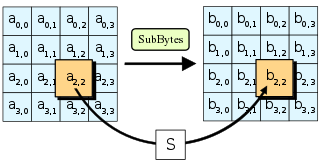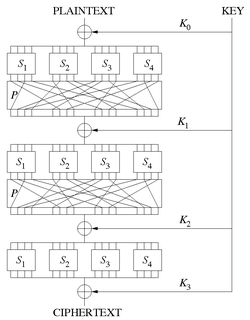Related Research Articles

The Advanced Encryption Standard (AES), also known by its original name Rijndael, is a specification for the encryption of electronic data established by the U.S. National Institute of Standards and Technology (NIST) in 2001.
In cryptography, a block cipher is a deterministic algorithm operating on fixed-length groups of bits, called blocks. It uses an unvarying transformation, that is, it uses a symmetric key. They are specified elementary components in the design of many cryptographic protocols and are widely used to implement the encryption of large amounts of data, including data exchange protocols.
Differential cryptanalysis is a general form of cryptanalysis applicable primarily to block ciphers, but also to stream ciphers and cryptographic hash functions. In the broadest sense, it is the study of how differences in information input can affect the resultant difference at the output. In the case of a block cipher, it refers to a set of techniques for tracing differences through the network of transformation, discovering where the cipher exhibits non-random behavior, and exploiting such properties to recover the secret key.

Serpent is a symmetric key block cipher that was a finalist in the Advanced Encryption Standard (AES) contest, where it was ranked second to Rijndael. Serpent was designed by Ross Anderson, Eli Biham, and Lars Knudsen.

In cryptography, an SP-network, or substitution–permutation network (SPN), is a series of linked mathematical operations used in block cipher algorithms such as AES (Rijndael), 3-Way, Kalyna, Kuznyechik, PRESENT, SAFER, SHARK, and Square.

In cryptography, DES-X is a variant on the DES symmetric-key block cipher intended to increase the complexity of a brute-force attack using a technique called key whitening.
In cryptography, Khufu and Khafre are two block ciphers designed by Ralph Merkle in 1989 while working at Xerox's Palo Alto Research Center. Along with Snefru, a cryptographic hash function, the ciphers were named after the Egyptian Pharaohs Khufu, Khafre and Sneferu.
In cryptography, Madryga is a block cipher published in 1984 by W. E. Madryga. It was designed to be easy and efficient for implementation in software. Serious weaknesses have since been found in the algorithm, but it was one of the first encryption algorithms to make use of data-dependent rotations, later used in other ciphers, such as RC5 and RC6.
In cryptography, REDOC II and REDOC III are block ciphers designed by Michael Wood (cryptographer) for Cryptech Inc and are optimised for use in software. Both REDOC ciphers are patented.

In cryptography, ICE is a symmetric-key block cipher published by Kwan in 1997. The algorithm is similar in structure to DES, but with the addition of a key-dependent bit permutation in the round function. The key-dependent bit permutation is implemented efficiently in software. The ICE algorithm is not subject to patents, and the source code has been placed into the public domain.
In cryptography, integral cryptanalysis is a cryptanalytic attack that is particularly applicable to block ciphers based on substitution–permutation networks. It was originally designed by Lars Knudsen as a dedicated attack against Square, so it is commonly known as the Square attack. It was also extended to a few other ciphers related to Square: CRYPTON, Rijndael, and SHARK. Stefan Lucks generalized the attack to what he called a saturation attack and used it to attack Twofish, which is not at all similar to Square, having a radically different Feistel network structure. Forms of integral cryptanalysis have since been applied to a variety of ciphers, including Hierocrypt, IDEA, Camellia, Skipjack, MISTY1, MISTY2, SAFER++, KHAZAD, and FOX.
In cryptography, Cobra is the general name of a family of data-dependent permutation based block ciphers: Cobra-S128, Cobra-F64a, Cobra-F64b, Cobra-H64, and Cobra-H128. In each of these names, the number indicates the cipher's block size, and the capital letter indicates whether it is optimized for implementation in software, firmware, or hardware.
In cryptography, Q is a block cipher invented by Leslie McBride. It was submitted to the NESSIE project, but was not selected.
In cryptography, DFC is a symmetric block cipher which was created in 1998 by a group of researchers from École Normale Supérieure, CNRS, and France Télécom and submitted to the AES competition.
In cryptography, KN-Cipher is a block cipher created by Kaisa Nyberg and Lars Knudsen in 1995. One of the first ciphers designed to be provably secure against ordinary differential cryptanalysis, KN-Cipher was later broken using higher order differential cryptanalysis.
In cryptography, Spectr-H64 is a block cipher designed in 2001 by N. D. Goots, A. A. Moldovyan and N. A. Moldovyan. It relies heavily on the permutation of individual bits, so is much better suited to implementation in hardware than in software.
In cryptography, COCONUT98 is a block cipher designed by Serge Vaudenay in 1998. It was one of the first concrete applications of Vaudenay's decorrelation theory, designed to be provably secure against differential cryptanalysis, linear cryptanalysis, and even certain types of undiscovered cryptanalytic attacks.
In cryptography, M8 is a block cipher designed by Hitachi in 1999. The algorithm negotiates introduced in 1997 M6, with the modified key length, which is enlarged to 64 bits or more. This cipher operates with Feistel network and designed to reach high performance on small implementation or 32 bits devices. For instance, by using round numbers = 10 it present encryption speed at 32 Mbps for dedicated hardware of 6K gates and 25 MHz clock or 208 Mbps for program, that uses C-language and Pentium-I 266 MHz. Due to the openness of description, it should not be used in open or multivendor software.

In cryptography, Twofish is a symmetric key block cipher with a block size of 128 bits and key sizes up to 256 bits. It was one of the five finalists of the Advanced Encryption Standard contest, but it was not selected for standardization. Twofish is related to the earlier block cipher Blowfish.
In cryptography, a known-key distinguishing attack is an attack model against symmetric ciphers, whereby an attacker who knows the key can find a structural property in cipher, where the transformation from plaintext to ciphertext is not random. There is no common formal definition for what such a transformation may be. The chosen-key distinguishing attack is strongly related, where the attacker can choose a key to introduce such transformations.
References
- B. Kidney, H. Heys, T. Norvell (November 12, 2003). "A Weight Based Attack on the CIKS-1 Block Cipher" (PDF/PostScript). Retrieved January 3, 2007.Cite journal requires
|journal=(help)CS1 maint: multiple names: authors list (link) - B. Kidney; H. Heys; T. Norvell (2004). "A Differential Attack on the CIKS-1 Block Cipher" (PDF/PostScript). Retrieved January 3, 2007.Cite journal requires
|journal=(help)